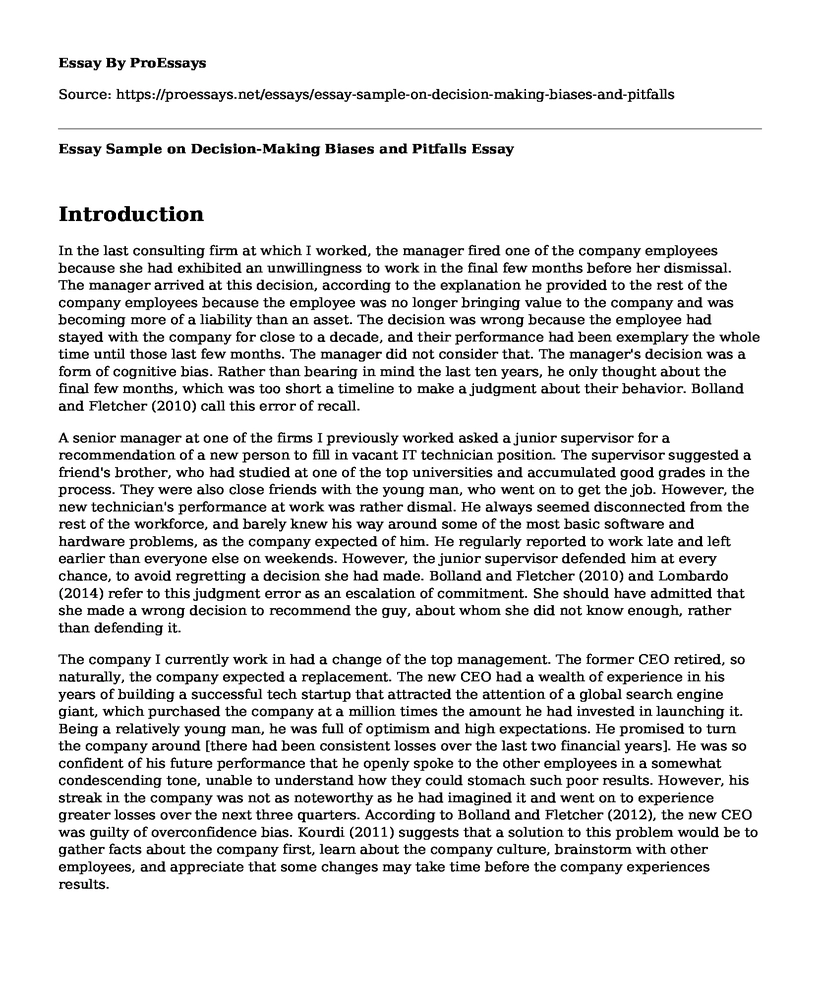Introduction
In the last consulting firm at which I worked, the manager fired one of the company employees because she had exhibited an unwillingness to work in the final few months before her dismissal. The manager arrived at this decision, according to the explanation he provided to the rest of the company employees because the employee was no longer bringing value to the company and was becoming more of a liability than an asset. The decision was wrong because the employee had stayed with the company for close to a decade, and their performance had been exemplary the whole time until those last few months. The manager did not consider that. The manager's decision was a form of cognitive bias. Rather than bearing in mind the last ten years, he only thought about the final few months, which was too short a timeline to make a judgment about their behavior. Bolland and Fletcher (2010) call this error of recall.
A senior manager at one of the firms I previously worked asked a junior supervisor for a recommendation of a new person to fill in vacant IT technician position. The supervisor suggested a friend's brother, who had studied at one of the top universities and accumulated good grades in the process. They were also close friends with the young man, who went on to get the job. However, the new technician's performance at work was rather dismal. He always seemed disconnected from the rest of the workforce, and barely knew his way around some of the most basic software and hardware problems, as the company expected of him. He regularly reported to work late and left earlier than everyone else on weekends. However, the junior supervisor defended him at every chance, to avoid regretting a decision she had made. Bolland and Fletcher (2010) and Lombardo (2014) refer to this judgment error as an escalation of commitment. She should have admitted that she made a wrong decision to recommend the guy, about whom she did not know enough, rather than defending it.
The company I currently work in had a change of the top management. The former CEO retired, so naturally, the company expected a replacement. The new CEO had a wealth of experience in his years of building a successful tech startup that attracted the attention of a global search engine giant, which purchased the company at a million times the amount he had invested in launching it. Being a relatively young man, he was full of optimism and high expectations. He promised to turn the company around [there had been consistent losses over the last two financial years]. He was so confident of his future performance that he openly spoke to the other employees in a somewhat condescending tone, unable to understand how they could stomach such poor results. However, his streak in the company was not as noteworthy as he had imagined it and went on to experience greater losses over the next three quarters. According to Bolland and Fletcher (2012), the new CEO was guilty of overconfidence bias. Kourdi (2011) suggests that a solution to this problem would be to gather facts about the company first, learn about the company culture, brainstorm with other employees, and appreciate that some changes may take time before the company experiences results.
Conclusion
The Bolland and Fletcher text would be the most beneficial because it would enable them to understand the kind of decisions they are making and their potential impacts. Furthermore, it would enhance the analysis of their own choices by helping them acknowledge why they think the way they do. That way, they would make more informed decisions on an individual level. By keeping biases at bay, they would be levelheaded enough to be more balanced in their approach than they otherwise would be.
References
Bolland, E., & Fletcher, F. (2012). Solutions: Business problem solving. (Available from Trident Online Library).
Kourdi, J. (2011). Chapter 10: Avoiding the pitfalls and developing an action plan. Effective Decision Making: 10 Steps to Better Decision Making and Problem Solving. London: Marshall Cavendish International [Asia] Pte Ltd. [eBook Business Collection]
Lombardo, L. (2014, June 10). Common biases and judgment errors in decision making organizational behavior [Video file]. Retrieved from https://www.youtube.com/watch?v=cAbdmV3VOwA
Cite this page
Essay Sample on Decision-Making Biases and Pitfalls. (2022, Jun 19). Retrieved from https://proessays.net/essays/essay-sample-on-decision-making-biases-and-pitfalls
If you are the original author of this essay and no longer wish to have it published on the ProEssays website, please click below to request its removal:
- Crisis Management Essay Example
- Institutional Entrepreneurship, Service Innovation and Operation Management of Service-Oriented Government in China
- Secure Your Business: Essay Sample on Implementing Effective Data Security Programs
- Supervisors: Balancing Work and Management Challenges - Essay Sample
- Paper Example on Struggle for Power & Supremacy: Who's Ahead?
- Paper Example on Main Character Achieves Success Through Mission Command
- Essay Example on Cost Leadership Strategy: A Simplified Model







